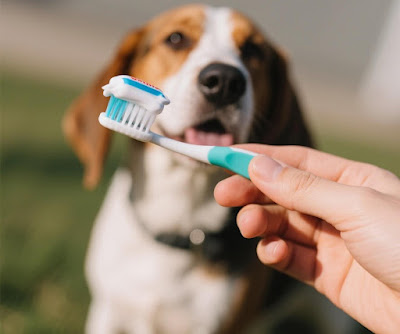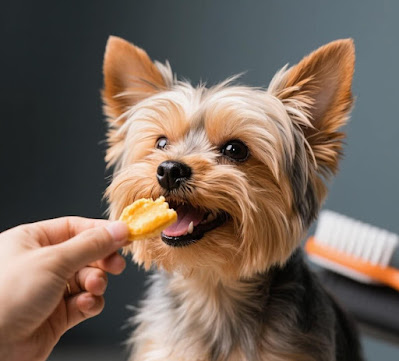How to Brush Your Small Dog's Teeth: A Step-by-Step Visual Guide for Beginners
Introduction: Mastering the Art of Small Dog Dental Care
Does the thought of brushing your small dog's teeth fill you with dread? You're not alone! Many small dog owners find this task daunting, yet it's one of the most crucial aspects of their pet's overall health. Neglecting dental hygiene can lead to painful dental diseases, bad breath, and even more serious systemic health issues.
But what if we told you it doesn't have to be a struggle? This comprehensive guide will break down the process of brushing your small dog's teeth into simple, manageable steps. We'll provide practical tips, visual aids, and advice on how to make this essential routine a positive and stress-free experience for both you and your tiny companion. Get ready to transform your dog's oral health and enjoy fresher kisses!
Why Daily Brushing is Crucial for Small Dogs: More Than Just Fresh Breath
Small dogs are disproportionately affected by dental disease. Their compact jaws often mean overcrowded teeth, creating ideal environments for plaque and tartar to accumulate. Regular brushing is your best defense against:
- Periodontal Disease: The most common disease in dogs, leading to pain, infection, and tooth loss.
- Persistent Bad Breath (Halitosis): Often a primary indicator of dental issues.
- Pain and Discomfort: Untreated dental problems can cause significant pain, affecting your dog's eating habits and overall demeanor.
- Systemic Health Issues: Bacteria from dental infections can enter the bloodstream, potentially affecting vital organs like the heart, kidneys, and liver.
- Costly Vet Bills: Regular home care can significantly reduce the need for expensive professional dental cleanings and extractions.
The Tools You'll Need for a Successful Brushing Session
Before you begin, gather your supplies. Having everything ready will make the process smoother for both of you:
- Dog-Specific Toothpaste: Never use human toothpaste! It contains ingredients toxic to dogs. Opt for an enzymatic dog toothpaste in a flavor your dog loves. (Need help choosing? Check out our guide: BEST TOOTHPASTE ARTICLE)
- Dog Toothbrush:
- Finger Brush: Great for beginners and dogs who are sensitive to traditional brushes.
- Dual-Headed Toothbrush: Designed to clean both sides of the tooth simultaneously.
- Small Head Toothbrush: Essential for navigating tiny mouths and reaching all teeth.
- High-Value Treats: Essential for positive reinforcement.
- Patience and Positive Attitude: Your most important tools!
Preparation Before You Start: Setting the Stage for Success
Making brushing a positive experience starts even before the brush touches their teeth:
- Choose the Right Time: Pick a moment when your dog is calm and relaxed, perhaps after a walk or playtime, but not immediately after eating.
- Select a Comfortable Spot: A quiet, familiar place where your dog feels secure.
- Gradual Introduction (Desensitization):
- Start by simply touching your dog's muzzle and lifting their lips gently for a few seconds. Praise and reward.
- Next, let them lick a tiny bit of dog toothpaste from your finger.
- Once they're comfortable with that, try rubbing a small amount of toothpaste on their gums with your finger.
Step-by-Step Guide to Brushing Your Small Dog's Teeth
Now that you're prepared, let's get to the actual brushing. Remember to be gentle, patient, and keep sessions short, especially at first.
Step 1: Introduce the Toothpaste and Brush
 |
| Introducing dog toothpaste to your pet. |
Let your dog lick a small amount of toothpaste from the brush. This helps them get accustomed to the taste and texture of the brush.
Step 2: Start with a Finger Brush (If Needed)
If your dog is hesitant, begin with a finger brush. Apply a small amount of toothpaste and gently rub it along their outer gums and teeth.
Step 3: Transition to a Dog Toothbrush
 |
| Preparing the dog toothbrush. |
Once your dog is comfortable with the finger brush, apply toothpaste to a small dog toothbrush. Hold the brush at a 45-degree angle to the gumline.
Step 4: Gentle Circular Motions
Using gentle, circular motions, brush the outer surfaces of your dog's teeth. Focus on the gumline, where plaque tends to accumulate most. You don't need to brush the inner surfaces, as your dog's tongue usually keeps them clean.
Step 5: Focus on All Teeth
 |
| Effective brushing strokes for dog dental care. |
Work your way around your dog's mouth, paying special attention to the back teeth, which are often the most problematic. Keep sessions short – a minute or two is plenty, especially when starting out.
Step 6: Reward and Praise
Immediately after each brushing session, reward your dog with a high-value treat, lots of praise, and affection. This positive reinforcement is crucial for building a good association with brushing.
Tips for Stubborn or Fearful Dogs: Making Brushing Easier
Some dogs are naturally more resistant. Here's how to handle them:
- Patience is Paramount: Never force your dog. This will only create a negative association.
- Shorter, More Frequent Sessions: If a full minute is too much, do 10-20 seconds multiple times a day.
- High-Value Rewards: Use their absolute favorite treats.
- Consult Your Vet: If resistance persists, there might be an underlying dental issue causing pain.
- Consider Alternatives: If brushing is truly impossible, discuss dental chews, water additives, or brushless gels with your vet. (For more on alternatives, see our guide on BEST TOOTHPASTE ARTICLE, specifically the Oratene gel).
Conclusion: A Healthy Smile, A Happy Dog
Brushing your small dog's teeth might seem challenging at first, but with patience, consistency, and the right approach, it can become a routine that significantly benefits their health and well-being. A clean mouth means a happier dog, fresher breath, and fewer trips to the vet for painful dental procedures.
 |
| The joy of a healthy small dog's smile. |
Start today, even if it's just for a few seconds. Every little bit helps! Your furry friend deserves a lifetime of comfort and joy, and it all begins with a healthy smile.
For a complete guide to all aspects of small dog dental health, be sure to check out our comprehensive resource:
"The Ultimate Guide to Small Dog Dental Health: A Step-by-Step Owner's Manual"
Don't forget to choose the right toothpaste for your small dog. Find our top recommendations here: BEST TOOTHPASTE ARTICLE



